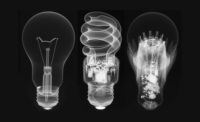In the past, factory machine-vision systems were traditionally linked to a central processor. While this approach did have its advantages, such as limited computer hardware costs, it also had various drawbacks. Because the processing was divided among multiple cameras, system performance was diminished. Further, centrally controlled vision systems were susceptible to downtime. If one camera had a problem, the whole system was apt to go offline.
But today, a new breed of vision sensors feature low-cost, built-in computing power that eliminate the need for central control, as well as new communications platforms that enhance the interconnectivity and interoperability of the technology. These "smart cameras" were developed in the early 1990s and have evolved into the de facto standard in affordable, machine vision inspection.
Cost-effective
Until recently, the costs and technical limitations of traditional machine vision systems made it unfeasible for many manufacturers to network the technology on a widespread basis. But the latest generation in machine vision systems allows automated inspections that are more cost-effective and reliable than before. In addition, there is a strong trend in the industry for the deployment of vision sensors throughout the plant to provide in-line process monitoring and data delivery in manufacturing.
Machine vision is based on the same technology that is used in optical character readers or the scanners that convert paper documents into electronic files. The technology relies on a camera to take a picture of a designated object and then converts that image into a stream of digital information that can be read by a computer.
Machine vision is expected to find growing use in factory applications. The Automated Imaging Association (Ann Arbor, MI) says that worldwide machine vision equipment sales in 2001 were $5.5 billion, a decline of 11% from 2000, but projects that sales could reach $9.1 billion by 2006.
One recent improvement in machine- vision sensor technology has been the introduction of advanced Ethernet connectivity. Previously, the factory floor was not integrated with the rest of the business enterprise and this created islands of information in manufacturing plants. By confining this critical data to weekly or monthly reports, real-time decision-making was constrained.
In the past, one hurdle to enterprise-wide integration was that factory floors have traditionally been built with special purpose industrial networks, while offices are typically networked using Ethernet standards. Using Ethernet in the plant floor enables manufacturing to be linked with the rest of the enterprise, as well as with the Internet at large.
Machine vision sensors with Ethernet connectivity provide a powerful option for network managers who need to integrate their machine vision with their Enterprise Resource Planning (ERP) systems. While traditional machine vision systems were often isolated and limited in their range of applications, new networks of vision sensors, often called Visual Data Networks, allow timely reporting of such statistics as units produced, orders shipped and defects found. These data can be sent directly into the plant's ERP systems via the Ethernet for executives to evaluate. Plants such as TI-Automotive (Meriden, CT) are now making this factory-floor, visual data available to their suppliers over the Web to improve the inventory process, expedite warranty returns and recalls, and to verify production processes (see "Eyes on the Plant Floor").
With a vision sensor's Ethernet capability, users can easily perform maintenance, monitoring and diagnostics of large numbers of vision sensors from remote locations. Because the factory network relies on the same standard protocols used on the broader Internet, the range of this activity extends beyond the individual factory itself. Users can upload data to a desktop program or download the parameters to the vision sensors on the shop floor, from hundreds or even thousands of miles away. A Visual Data Net-work allows manufacturers to remotely monitor and control factory equipment over the Web to find out why it is running slowly and to prevent it from breaking down.
Vision Networking 101
To bring this network online requires some basic understanding of the protocols available in the marketplace. The protocol that is supported by most vision sensors' Ethernet connection is Transmission Control Protocol/Internet Protocol, more commonly known as TCP/IP, the same suite of communications protocols used to transport data on the Internet. Each vision sensor has an IP address that identifies it uniquely on a network. Each sensor acts as a TCP server, which means that another application, which is referred to as the client application, must establish the connection and request data from it.
This does not mean that the communication is one way. After the connection is established, the server and client exchange data in both directions. The client application is usually a software user interface that runs on a personal computer equipped with an Ethernet card. The PC can be anywhere in the plant or even in other geographic locations, with connection via an intranet or the Internet. Software then initiates a two-way communications session; the PC receives images and inspection data, while the vision sensors on the plant floor receive system commands and parameters such as exposure time and threshold.
In order to establish a connection, a client application must be directed to the correct IP address, and to the correct TCP port. In TCP/IP protocol, a TCP port number is used in conjunction with the IP address to identify a specific application running on a network node such as a computer or Ethernet-capable device.
A unique communications 'path' or 'pipe' is defined by the combination of an IP address and a TCP port number. This is called a socket. A socket tells the client application exactly where to look for its information.
A network node identified with one IP address can use multiple TCP ports at the same time, that is, several sockets can be established between it and other nodes. Some common network applications that use TCP/IP have well-known port numbers assigned to them. For instance, FTP uses port 32 and Telnet uses port 23.
EtherNet or EtherNet/IP?
EtherNet/IP is an open specification of network communication protocol standards that is optimized to support real-time control system communication needs. EtherNet/IP is an industrial networking standard that takes advantage of commercial off-the-shelf Ethernet communication chips and cables. IP, on the other hand, stands for industrial protocol, and is what distinguishes this network. EtherNet/IP offers the reliable, deterministic performance of industrial networks such as ControlNet and DeviceNet, with the speed and convenience of standard Ethernet. This means EtherNet/IP-enabled vision sensors can easily connect to complex devices such as Programmable Logic Controllers (PLCs), motion controllers and human-machine interfaces without custom software.
In addition to EtherNet/IP, Modbus protocol is common in today's advanced machine-vision sensors. Modbus and Modbus/TCP are simple, vendor-neutral communication protocols intended for supervision and control of automation equipment. The most common use of the protocols is for Ethernet attachment of PLCs, input/output (I/O) modules and gateways to other simple field buses or I/O networks. The new Modbus drivers incorporated with the latest vision sensors allow them to act as Modbus slaves over a serial or Ethernet connection. The drivers extend the capabilities of the vision sensor to share its data with other devices on the factory floor and the enterprise.
Link it
New machine vision products are on the market that work in conjunction with vision sensors to expand their information sharing capabilities. Users can create sophisticated monitoring systems that will display inspection images and application specific information from all vision sensors in the plant on standard video monitors. In addition, newly available linking products can serve as communication bridges to industrial networks such as Profibus, or DeviceNet. Rather than providing a simple video output with overlaid text, users can create monitoring applications that look like a familiar Windows program. This environment also allows the display of multiple images at different sizes and resolutions. In addition to images, other components such as tables and text can be displayed. With these capabilities, users can create monitoring applications that have a totally customizable appearance.
TECH TIPS
- New networking technology allows images captured through machine vision systems to be viewed by decision makers from a variety of departments or locations via Ethernet connections or the Internet.
- An improvement in machine vision sensor technology has been the introduction of advanced Ethernet connectivity that allows the factory floor to be integrated with the rest of the enterprise.
- The protocol supported by most vision sensors' Ethernet connection is Transmission Control Protocol/Internet Protocol (TCP/IP).




